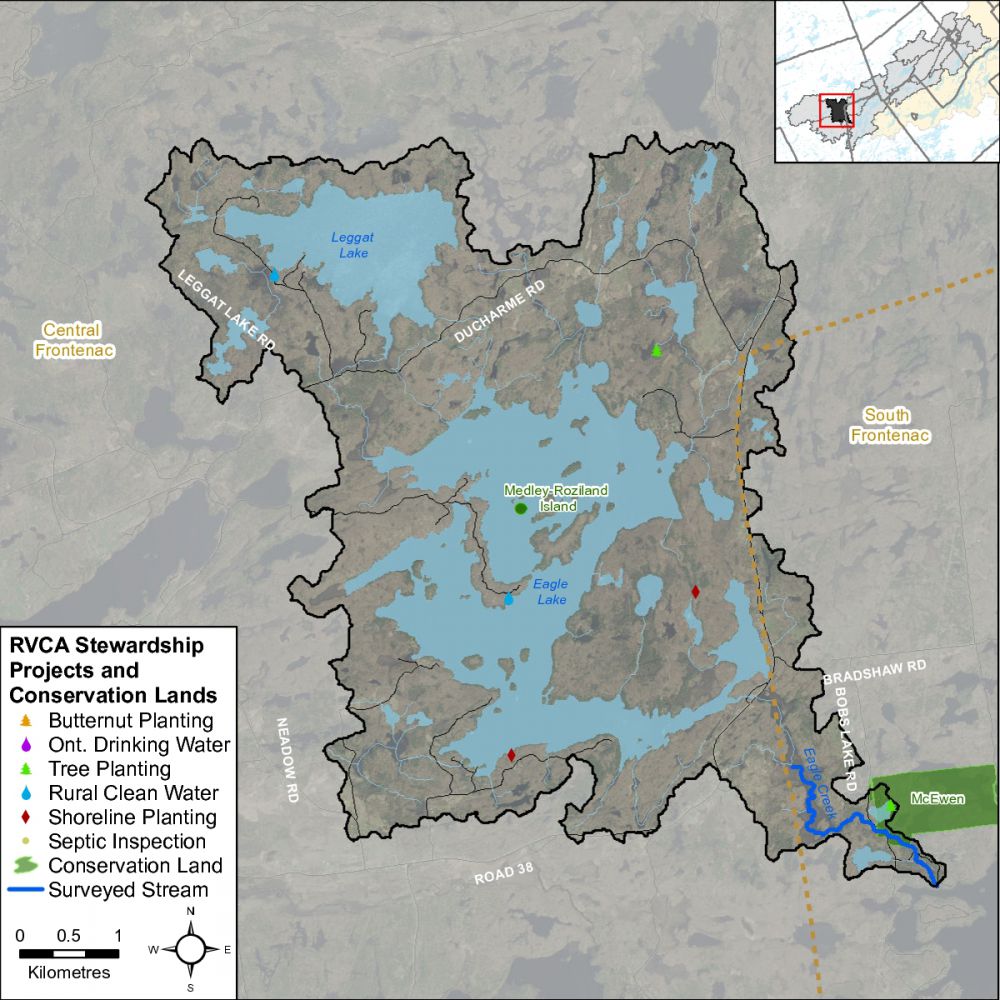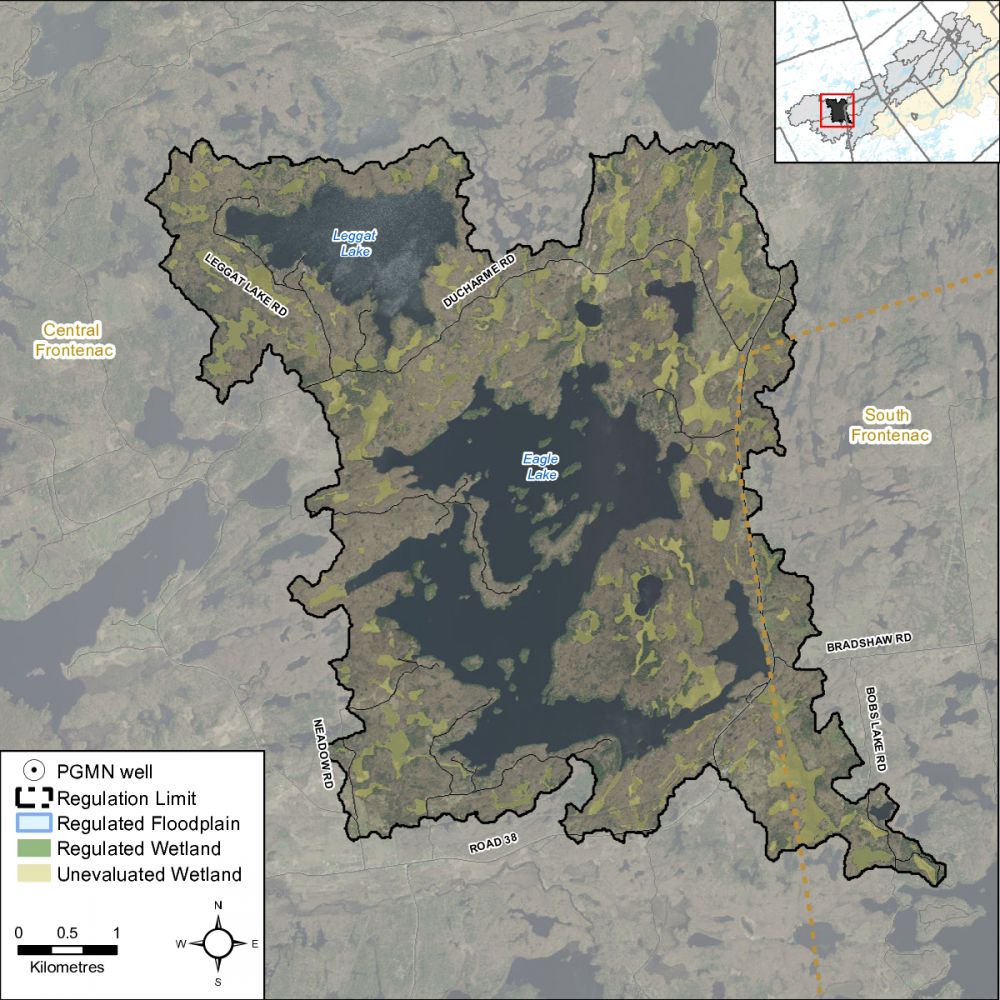5.0 Eagle Lake Catchment: Stewardship and Water Resources Protection
The RVCA and its partners are working to protect and enhance environmental conditions in the Tay River Watershed. Figure 78 shows the location of all stewardship projects completed in the Eagle Lake catchment.
5.1 Rural Clean Water
The Rural Clean Water Program provides technical and financial assistance to farmers and other rural landowners, to aid in the implementation of projects that protect water quality. Funding is granted to those projects that support best management practices for application in the protection and improvement of surface and ground water resources. The program also supports climate change adaptation and low impact development projects as well as educating rural landowners about environmental stewardship of private property. Examples of supported projects include livestock exclusion fencing, controlled tile drainage, cover crops, erosion control, well related projects, and many more. For a list of eligible projects and to apply for funding, see Rural Clean Water.
In the Eagle Lake catchment from 2011 to 2016, one erosion control projects was completed; prior to this, one well upgrade had been completed. Total value of the two projects is $30,685 with $4,000 of that amount funded through grant dollars from the RVCA.
5.2 Private Land Forestry
Forest cover and tree planting continues to be one of the most widely supported strategies to improve our environment. The many benefits of forest cover include carbon sequestration, flood mitigation and water quality improvement as well as providing wildlife habitat.
Through the RVCA's Trees for Tomorrow Program (and its predecessors), 2,000 trees were planted at two sites resulting in the reforestation of one hectare. Total project value of the two projects in the Eagle Lake catchment is $1,575 with $1,305 of that amount coming from fundraising sources. For more information about the Program and landowner eligibility, please see the following: Tree Planting in the Rideau Valley Watershed and Trees for Tomorrow.
An additional 34 butternut trees were planted through the RVCA Butternut Recovery Program as part of efforts to introduce healthy seedlings from tolerant butternuts into various locations across Eastern Ontario.
5.3 Shoreline Naturalization
Natural shoreline buffers rich in native plants are critically important to protecting the health of our lakes, rivers and streams. Shoreline vegetation protects water quality and aquatic habitat by intercepting potentially harmful contaminants such as nutrients, pollutants and sediment, regulating water temperatures, slowing runoff and providing important fish and wildlife habitat. Natural shorelines also help improve climate change resiliency by increasing flood storage and providing protection from erosion during extreme weather events.
Though the RVCA’s Shoreline Naturalization Program, landowners (private and public property owners) have naturalized more than 2.3 km of shoreline in the Tay Watershed by planting over 10,563 native trees and shrubs at 96 sites since 2008. In the Eagle Lake catchment, a total of 190 native trees and shrubs have been planted along 106 metres of shoreline at an average buffer width of three metres for a total project value of $1,569.
5.4 Fish and Wetland Habitat
One of the primary sites for Lake Trout spawning at Eagle Lake is the extensive shoals opposite Camp Oconto. With Ontario Ministry of Natural Resources & Forestry (OMNRF) approval, rehabilitation of this shoal was undertaken in 2006. Eagle Lake Property Owners’ Association volunteers, along with stewardship rangers from the Frontenac Stewardship Council, shoveled approximately 50 tons of suitably sized rocks onto three sites of this shoal. Spawning activity at this shoal has been directly observed by OMNRF staff in the fall of 2014 and 2015.
An OMNRF-directed creel survey in the spring and summer of 2010 indicated self-sustaining populations of Smallmouth and Largemouth Bass, as well as Northern Pike.
In 2008, OMNRF initiated a program (referred to as Broad-scale Monitoring) to assess the health of fish populations by conducting netting surveys. At Eagle Lake in 2008, 32 sites were surveyed and 13 different fish species netted, including 5 Lake Trout (4 stocked and 1 natural fish). The second survey in 2014 collected 14 species at 30 sites, but no Lake Trout. Broad-scale monitoring was again done at Eagle Lake in 2018 with 44 sites surveyed that netted 16 different fish species including one natural Lake Trout.
According to OMNRF records, Eagle Lake has been stocked with Lake Trout 49 times since 1917. It was last stocked in 1994.
On two occasions, Eagle Lake has had a netting survey specifically to assess the Lake Trout population. This involves setting nets at multiple locations at the proper depth based on water temperature to ensure optimal net placement. In the spring of 1999, nets at 30 widely distributed sites netted 54 Lake Trout only one of which was a natural fish. Of the 53 stocked Lake Trout, their weight class indicated that about 80 percent likely resulted from the last stocking in 1994. A similarly conducted netting survey in the summer of 2016 netted only one large Lake Trout.
5.5 Valley, Stream, Wetland and Hazard Lands
The Eagle Lake catchment covers 34 square kilometres and contains nine square kilometres of wetland along with 64.3 kilometres of stream. None of these natural features are subject to the regulation limit of Ontario Regulation 174/06 (Figure 79) for the protection of wetland areas and river or stream valleys that are affected by flooding and erosion hazards.
For areas where no regulation limit exists, protection of the catchment’s watercourses is provided through the “alteration to waterways” provision of the regulation.
5.6 Vulnerable Drinking Water Areas
Mississippi-Rideau Source Water Protection program has mapped a small part of the catchment as a Significant Groundwater Recharge Areas and all of the catchment as a Highly Vulnerable Aquifer. This means that the nature of the overburden (thin soils, fractured bedrock) does not provide a high level of protection for the underlying groundwater making the aquifer more vulnerable to contaminants released on the surface. There are no Well-Head Protection Areas in the catchment.
The Mississippi-Rideau Source Protection Plan includes policies that focus on the protection of groundwater region-wide due to the fact that most of the region, which encompasses the Mississippi and Rideau watersheds, is considered Highly Vulnerable Aquifer. For detailed maps and policies that have been developed to protect drinking water sources, visit the Mississippi-Rideau Source Protection Region website.

